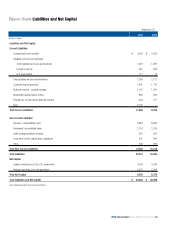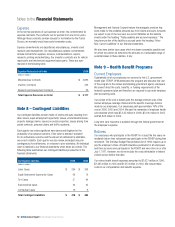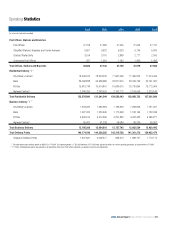US Postal Service 2006 Annual Report Download - page 57
Download and view the complete annual report
Please find page 57 of the 2006 US Postal Service annual report below. You can navigate through the pages in the report by either clicking on the pages listed below, or by using the keyword search tool below to find specific information within the annual report.
2006 Annual Report United States Postal Service | 55
In addition to the cost of workers’ compensation claims, Office of Workers
Compensation Programs charges us an administrative fee for processing
claims. In 2006, the administrative fee, which is included in the expense
above, was $45 million, compared to $56 million in 2005 and $44 million
in 2004.
Note 12 – Revenue Forgone
Our operating revenue includes accruals for revenue forgone. Revenue
is forgone when Congress mandates that we provide free or reduced fee
mail for designated mailers. Congress appropriates money to reimburse us
for the revenue that we have forgone in providing these services.
In 2006 we included as operating revenue $99 million, $109 million for
2005 and $36 million for 2004.
We estimate the amount of service that will be provided in the current
year and send a request to Congress. At the end of the year we reconcile
the request with the actual usage. If the actual usage is higher than our
estimate we send a supplemental request to Congress for additional
funding. If the actual usage is lower, we offset the over funding against the
next funding request. The requested amounts are recorded as government
receivables until the appropriations are received.
Under the Revenue Forgone Reform Act of 1993, Congress is required
to reimburse us $29 million annually through 2035 (42 years). This
reimbursement is for two purposes: services we performed in 1991, 1992
and 1993 for which we have not yet been paid; and for shortfalls in the
reimbursement for the costs we incurred for processing and delivering
certain non-profit mail from 1994 through 1998.
The Revenue Forgone Reform Act of 1993 authorized a total of $1,218
million in payments. We calculated the present value of these future
reimbursements, at 7% interest, to be approximately $390 million. We
recognized the $390 million as revenue during fiscal years 1991 through
1998. The amount receivable as of the years ended September 30 was
$357 million in 2006 and $360 million in 2005.
The total receivable for revenue forgone as of the years ended September
30 was $490 million in 2006 and $470 million in 2005.
Note 13 – Emergency Preparedness
Funding
In 2001, the United States was a victim of biological terrorism through
the mail. In response, we implemented process changes and technology
applications to reduce the risk to both our employees and our customers.
The President of the United States and Congress authorized funding of
$762 million in fiscal year 2002 to assist in paying for some of these
safety measures, and to replace or repair postal facilities damaged
or destroyed on September 11, 2001. As of September 30, 2004, all
2002 emergency preparedness appropriations were fully expended or
committed.
In December 2004, an appropriation by Congress of $503 million
provided additional funds for Biohazard Detection Systems, Ventilation
Filtration Systems, and an irradiation facility. Of these funds $138 million
remains to be expended or committed.
We recognize the revenue as we depreciate the capital equipment
purchased with the appropriation. The emergency preparedness
appropriations revenue recognized during the years ended September 30
were $85 million in 2006, $45 million in 2005 and $92 million in 2004.
Appropriations that have not been recognized as revenue during the
years ended September 30 were $687 million in 2006 and $772 million
in 2005 with the current portion included in prepaid box rent and other
deferred revenue and the long term portion in deferred revenue on our
balance sheets.
The emergency preparedness expenses and capital equipment commit-
ments for the years ended September 30 are as follows:
Emergency Preparedness
Expenses and Commitments 2006 2005 2004
(Dollars in millions)
Operating Expenses:
Personnel Costs $ – $ – $ 9
Non-Personnel Costs 196 79 123
Total Operating Expenses $ 196 $ 79 $ 132
Capital Equipment Commitments $ 72 $ 313 $ 222
Not all emergency preparedness expenditures are covered by the
appropriations we receive. We are funding other costs of mail security and
employee protection such as maintenance and consumable supplies from
Postal Service revenue and charging them as operating expense.
Note 14 – Postal Reform
Postal reform legislation was considered in the 109th Congress, the
continuation of an effort beginning in 1996. Legislation had not yet been
approved as Congress returned from its election recess on November 13,
2006. It is possible that postal reform legislation will be considered during
this final session of the 109th Congress.
Notes to the Financial Statements
























